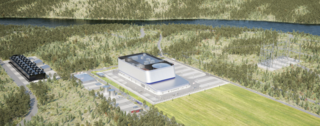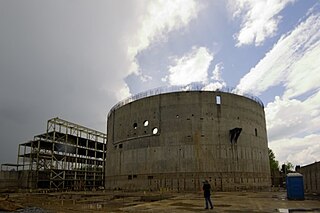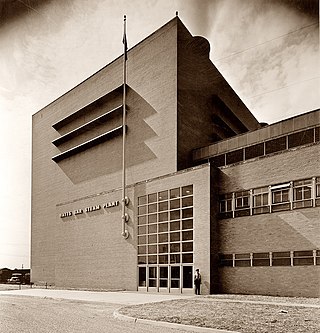
The Tennessee Valley Authority (TVA) is a federally owned electric utility corporation in the United States. TVA's service area covers all of Tennessee, portions of Alabama, Mississippi, and Kentucky, and small areas of Georgia, North Carolina, and Virginia. While owned by the federal government, TVA receives no taxpayer funding and operates similarly to a private for-profit company. It is headquartered in Knoxville, Tennessee, and is the sixth largest power supplier and largest public utility in the country.

The Shearon Harris Nuclear Power Plant is a nuclear power plant with a single Westinghouse designed pressurized-water nuclear reactor operated by Duke Energy. It was named in honor of W. Shearon Harris, former president of Carolina Power & Light. Located in New Hill, North Carolina, in the United States, about 20 miles (30 km) southwest of Raleigh, it generates 900 MWe, has a 523-foot (160 m) natural draft cooling tower, and uses Harris Lake for cooling. The reactor achieved criticality in January 1987 and began providing power commercially on May 2 of that year.

Norris Dam is a hydroelectric and flood control structure located on the Clinch River in Anderson County and Campbell County, Tennessee, United States. The dam was the first major project for the Tennessee Valley Authority, which had been created in 1933 to bring economic development to the region and control the rampant flooding that had long plagued the Tennessee Valley. The dam was named in honor of Nebraska Senator George Norris (1861–1944), a longtime supporter of government-owned utilities in general, and supporter of TVA in particular. The infrastructure project was listed on the National Register of Historic Places in 2016.

The Browns Ferry Nuclear Plant is located on the Tennessee River near Decatur and Athens, Alabama, on the north side of Wheeler Lake. The site has three General Electric boiling water reactor (BWR) nuclear generating units and is owned entirely by the Tennessee Valley Authority (TVA). With a generating capacity of nearly 3.8 gigawatts, it is the second most powerful nuclear plant in the United States, behind the Palo Verde Nuclear Generating Station in Arizona, and the most powerful generating station operated by TVA.

The Sequoyah Nuclear Plant is a nuclear power plant located on 525 acres (212 ha) located 7 miles (11 km) east of Soddy-Daisy, Tennessee, and 20 miles (32 km) north of Chattanooga, abutting Chickamauga Lake, on the Tennessee River. The facility is owned and operated by the Tennessee Valley Authority (TVA).

The Watts Bar Nuclear Plant is a Tennessee Valley Authority (TVA) nuclear reactor pair used for electric power generation. It is located on a 1,770-acre (7.2 km²) site in Rhea County, Tennessee, near Spring City, between the cities of Chattanooga and Knoxville. Watts Bar supplies enough electricity for about 1,200,000 households in the Tennessee Valley.

The Bellefonte Nuclear Generating Station (BLN) is an unfinished nuclear power plant in Hollywood, Alabama, United States.

The Enrico Fermi Nuclear Generating Station is a nuclear power plant on the shore of Lake Erie near Monroe, in Frenchtown Charter Township, Michigan on approximately 1,000 acres (400 ha). All units of the plant are operated by the DTE Energy Electric Company and owned by parent company DTE Energy. It is approximately halfway between Detroit, Michigan, and Toledo, Ohio. It is also visible from parts of Amherstburg and Colchester, Ontario as well as on the shore of Lake Erie in Ottawa County, Ohio. Two units have been constructed on this site. The first unit's construction started on August 4, 1956 and reached initial criticality on August 23, 1963, and the second unit received its construction permit on September 26, 1972. It reached criticality on June 21, 1985 and was declared commercial on November 18, 1988. The plant is connected to two single-circuit 345 kV Transmission Lines and three 120 kV lines. They are operated and maintained by ITC Transmission.
The "Nuclear Power 2010 Program" was launched in 2002 by President George W. Bush in 2002, 13 months after the beginning of his presidency, in order to restart orders for nuclear power reactors in the U.S. by providing subsidies for a handful of Generation III+ demonstration plants. The expectation was that these plants would come online by 2010, but it was not met.

Nuclear power in the United States is provided by 92 commercial reactors with a net capacity of 94.7 gigawatts (GW), with 61 pressurized water reactors and 31 boiling water reactors. In 2019, they produced a total of 809.41 terawatt-hours of electricity, which accounted for 20% of the nation's total electric energy generation. In 2018, nuclear comprised nearly 50 percent of US emission-free energy generation.

The Clinch River Nuclear Site (CRNS) is a project site owned by the Tennessee Valley Authority (TVA). It was once proposed as the Clinch River Breeder Reactor Project of the U.S. Atomic Energy Commission and the U.S. electric power industry to design and construct a sodium-cooled fast-neutron nuclear reactor. The project was opposed by President Carter.

The Cherokee Nuclear Power Plant is an uncompleted energy project 10 miles (16 km) outside Gaffney, South Carolina, United States. In the early 1970s, Duke Power started construction on a three-reactor nuclear power plant at the site. However, the project stalled due to economic problems by the early 1980s, leading to the project's eventual abandonment. In 1987, the power plant was the site of an underwater film studio built by Hollywood director James Cameron, for the film The Abyss.

The Hartsville Nuclear Plant is a canceled nuclear power plant project located near Hartsville, Tennessee. To be built and operated by the Tennessee Valley Authority, it was to have four General Electric boiling water reactors.

Between 2007 and 2009, 13 companies applied to the Nuclear Regulatory Commission (NRC) for construction and operating licenses to build 31 new nuclear power reactors in the United States. However, the case for widespread nuclear plant construction has been hampered due to inexpensive natural gas, slow electricity demand growth in a weak US economy, lack of financing, and safety concerns following the Fukushima nuclear disaster at a plant built in the early 1970s which occurred in 2011.

Washington Nuclear Project Nos. 1 and 4, abbreviated as WNP-1 and WNP-4 were two of the five nuclear power plants on which construction was started by the Washington Public Power Supply System (WPPSS) in order to meet projected electricity demand in the Pacific Northwest. WNP-1, WNP-2 and WNP-3 were part of the original 1968 plan, with WNP-4 and WNP-5 added in the early 1970s.
The Allens Creek Nuclear Power Plant was a proposed nuclear power plant to be located at Wallis, Texas, less than 50 miles from the western edge of Houston. The plant, consisting of two 1,150 MWe General Electric boiling water reactors, was ordered by Houston Lighting and Power Company (HL&P) in 1973, but public opposition, fueled in part by press coverage of problems at other nuclear plants around the country, led to lengthy public hearings and court action. In the meantime, construction costs escalated and the plant was officially canceled in 1982.
The Forked River Nuclear Power Plant was a proposed nuclear power plant in Lacey Township in Ocean County, New Jersey. It was proposed as a single 1,070 MW reactor in 1969 to be built by Combustion Engineering and operated by Jersey Central Power and Light. The facility would have been located on a site between JCP&L's existing Oyster Creek Nuclear Generating Station and the Garden State Parkway. Unlike the Oyster Creek Plant, the Forked River Plant would have a cooling tower to prevent the release of hot water into Oyster Creek and Barnegat Bay.
The Bailly Nuclear Power Plant was a nuclear power plant project to be located near the Indiana Dunes National Lakeshore in Porter County, Indiana, United States. The project was proposed by the Northern Indiana Public Service Company (NIPSCO) in 1967; however, it was cancelled in 1981.

Phipps Bend Nuclear Plant was a planned nuclear power generation facility that was to be constructed and operated by the Tennessee Valley Authority (TVA) in unincorporated Hawkins County, Tennessee. Proposed to house two reactor units, the power plant was estimated to cost $1.6 billion when it was first planned in late 1977, provide a generating capacity of 2,600,000 kilowatts. Following negative public reactions towards nuclear energy following the Three Mile Island accident and a decreasing demand for power due to regional economic decline, the TVA's board of directors voted to defer further construction of the power plant. By 1981, the plant was 40% complete and an estimated $1.5 billion in planning, engineering, and construction costs had accumulated. Construction never resumed, and the project was canceled overall in 1982 due to lower load growth than forecast. By the project's cancellation, the TVA had amassed over $2.6 billion in spending for the incomplete nuclear facility. After being auctioned off by the TVA in 1987, the land acquired for the plant would be under the ownership of Hawkins County's industrial development board, who converted most of the site into an industrial park. A 1 MW solar farm was built at the site in 2017.

Watts Bar Steam Plant was a 267-megawatt (MW), coal power plant operated by the Tennessee Valley Authority (TVA) located in Rhea County, Tennessee near the present site of Watts Bar Nuclear Plant and Watts Bar Dam. The plant was the first coal-fired power plant constructed by TVA.
















